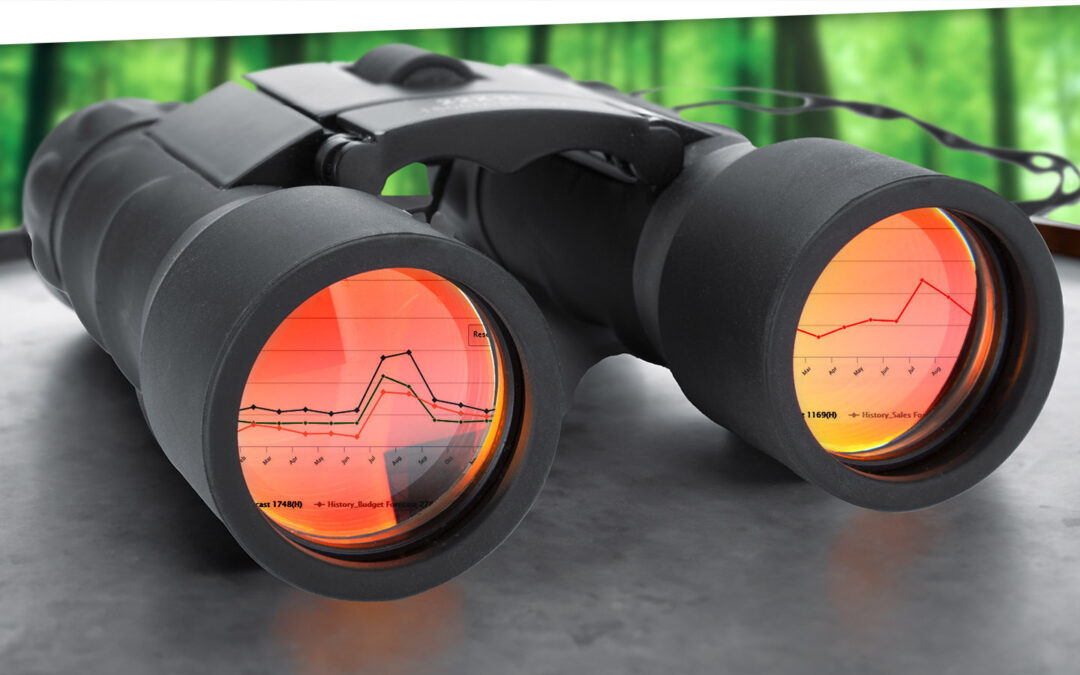Demand planners have to cope with multiple problems to get their job done. One is the Irritation of Intermittency. The “now you see it, now you don’t” character of intermittent demand, with its heavy mix of zero values, forces the use of advanced statistical methods, such as Smart Software’s patented Markov Bootstrap algorithm. But even within the dark realm of intermittent demand, there are degrees of difficulty: planners must further cope with the potentially costly Scourge of Skewness.
Skewness is a statistical term describing the degree to which a demand distribution is not symmetrical. The classic (and largely mythic) “bell-shaped” curve is symmetric, with equal chances of demand in any time period falling below or above the average. In contrast, a skewed distribution is lopsided, with most values falling either above or below the average. In most cases, demand data are positively skewed, with a long tail of values extending toward the higher end of the demand scale.
Bar graphs of two time series
Figure 1: Two intermittent demand series with different levels of skewness
Figure 1 shows two time series of 60 months of intermittent demand. Both are positively skewed, but the data in the bottom panel are more skewed. Both series have nearly the same average demand, but the one on top is a mix of 0’s, 1’s and 2’s, while the one on the bottom is a mix of 0’s, 1’s and 4’s.
 What makes positive skewness a problem is that it reduces an item’s fill rate. Fill rate is an important inventory management performance metric. It measures the percentage of demand that is satisfied immediately from on-hand inventory. Any backorders or lost sales reduce the fill rate (besides squandering customer good will).
What makes positive skewness a problem is that it reduces an item’s fill rate. Fill rate is an important inventory management performance metric. It measures the percentage of demand that is satisfied immediately from on-hand inventory. Any backorders or lost sales reduce the fill rate (besides squandering customer good will).
Fill rate is a companion to the other key performance metric: Service level. Service level measures the chance that an item will stock out during the replenishment lead time. Lead time is measured from the moment when inventory drops to or below an item’s reorder point, triggering a replenishment order, until the arrival of the replacement inventory.
Inventory management software, such as Smart Software’s SmartForecasts, can analyze demand patterns to calculate the reorder point required to achieve a specified service level target. To hit a 95% service level for the item in the top panel of Figure 1, assuming a lead time of 1 month, the required reorder point is 3; for the bottom item, the reorder point is 1. (The first reorder point is 3 to allow for the distinct possibility that future demand values will exceed the largest values, 2, observed so far. In fact, values as large as 8 are possible.) See Figure 2.
Histograms of two time series
Figure 2: Distributions of total demand during a replenishment lead time of 1 month
(Figure 2 plots the predicted distribution of demand over the lead time. The green bars represent the probability that any particular level of demand will materialize.)
Using the required reorder point of 3 units, the fill rate for the less skewed item is a healthy 93%. However, the fill rate for the more skewed item is a troubling 44%, even though this item too achieves a service level of 95%. This is the scourge of skewness.
The explanation for the difference in fill rates is the degree of skewness. The reorder point for the more skewed item is 1 unit. Having 1 unit on hand at the start of the lead time will be sufficient to handle 95% of the demands arriving during a 1 month lead time. However, the monthly demand could reach above 15 units, so when the more skewed unit stocks out, it will “stock out big time”, losing a much larger number of units.
Most demand planners would be proud to achieve a 95% service level and a 93% fill rate. Most would be troubled, and puzzled, by achieving the 95% service level but only a 44% fill rate. This partial failure would not be their fault: it can be traced directly to the nasty skewness in the distribution of monthly demand values.
There is no painless fix to this problem. The only way to boost the fill rate in this situation is to raise the service level target, which will in turn boost the reorder point, which finally will reduce both the frequency of stockouts and their size whenever they occur. In this example, raising the reorder point from 1 unit to 3 units will achieve a 99% service level and boost fill rate to a respectable, but not outstanding, 84%. This improvement would come at the cost of essentially tripling the dollars tied up in managing this more skewed item.
Thomas Willemain, PhD, co-founded Smart Software and currently serves as Senior Vice President for Research. Dr. Willemain also serves as Professor Emeritus of Industrial and Systems Engineering at Rensselear Polytechnic Institute and as a member of the research staff at the Center for Computing Sciences, Institute for Defense Analyses.
Related Posts

Looking for Trouble in Your Inventory Data
In this video blog, the spotlight is on a critical aspect of inventory management: the analysis and interpretation of inventory data. The focus is specifically on a dataset from a public transit agency detailing spare parts for buses.

Can Randomness be an Ally in the Forecasting Battle?
When we try to understand the complex world of logistics, randomness plays a pivotal role. This introduces an interesting paradox: In a reality where precision and certainty are prized, could the unpredictable nature of supply and demand actually serve as a strategic ally?
The quest for accurate forecasts is not just an academic exercise; it’s a critical component of operational success across numerous industries. For demand planners who must anticipate product demand, the ramifications of getting it right—or wrong—are critical. Hence, recognizing and harnessing the power of randomness isn’t merely a theoretical exercise; it’s a necessity for resilience and adaptability in an ever-changing environment.

Why MRO Businesses Need Add-on Service Parts Planning & Inventory Software
MRO organizations exist in a wide range of industries, including public transit, electrical utilities, wastewater, hydro power, aviation, and mining. To get their work done, MRO professionals use Enterprise Asset Management (EAM) and Enterprise Resource Planning (ERP) systems. These systems are designed to do a lot of jobs. Given their features, cost, and extensive implementation requirements, there is an assumption that EAM and ERP systems can do it all. In this post, we summarize the need for add-on software that addresses specialized analytics for inventory optimization, forecasting, and service parts planning.













